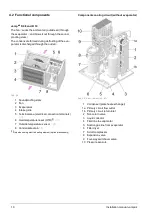
1 About this manual
3.7 Heating system fill-up water
In regard to the fill-up water quality, two key points
must be observed (in accordance with Guideline
VDI 2035):
–
Avoiding scale buildup (limescale)
–
Avoiding water-side corrosion (caused by oxygen
in the heating water)
The lowest possible rate of corrosion of the installed
metal materials is primarily achieved when the circula-
tion water is in the correct pH range (8.2 to 9.5), while
at the same time, the electrical conductivity is as low
as possible (50 to 100 µS/cm).
3.7.1 Avoiding scale buildup
What is scale buildup?
Scale buildup is the formation of firmly adhering depo-
sits on water-contacting walls of hot water heating
systems. This can subsequently lead to damage
(stress cracks in metal, leaks).
Causes of scale buildup
The cause of scaling is the presence of calcium carbo-
nate in the water.
The following calculation/table determines the total
permitted hardness of the fill-up water. If the value is
exceeded, the fill-up water must be treated, e.g. sof-
tened.
Calculation of the total permitted hardness of the
fill-up water
To use the table, the
specific system volume
for the
system must be determined:
System volume
divided by
total heat output
results in
the
specific system volume
1166 litres / 25 kW =
46.64 l/kW specific system
volume
Table: Total permitted hardness of the fill-up water
Total heat
output
Specific system volume (VDI 2035)
<20
l/kW
≥ 20 <50
l/kW
≥ 50
l/kW
< 50 kW
≤ 16.8°dH
≤ 11.2°dH
< 0.11°dH
50 - 200 kW
≤ 11.2°dH
≤ 8.4°dH
< 0.11°dH
20 - 600 kW
≤ 8.4°dH
< 0.11°dH
< 0.11°dH
> 600 kW
< 0.11°dH
< 0.11°dH
< 0.11°dH
In our example: if the total hardness of the fill-up
water is more than 11.2 dH, then the fill-up water
must be treated.
3.7.2 Avoiding water-side corrosion
Corrosion is usually triggered by the available oxygen
in the water. This value can be brought into a safe
range with proper planning, design, installation and
maintenance of the heating system. A constant input
of oxygen should be avoided.
Important in this regard:
–
Expansion tank
: Air must be prevented from
being drawn in when the heating system is coo-
ling down. Ensure:
–
Correct planning and implementation of the
expansion tank.
–
Regular check of the system pressure, expan-
sion tank pre-pressure.
–
Immediate repair of leaks in the heating system.
–
In the case of older underfloor heating, ensure
pipes are diffusion resistant
Check the pH of the fill-up water
–
The pH value must be between 8.2 and 9.5.
–
If this pH value does not self adjust after a week of
operation, it must be raised by adding 10 g/m³ tri-
sodium phosphate (Na3PO4) or 5 g/m³ sodium
hydroxide (NaOH). Allow 2 to 4 weeks of ope-
ration before further corrections.
–
Exception: If aluminium materials are used in the
heating system, a pH from 8.2 to 8.5 must be met
(pH> 8.5 increased corrosion tendency).
Resistance of materials to water constituents
Irrespective of legal requirements, the following limit
values in the heating water used for different mate-
rials may not be exceeded or fallen below in order to
ensure safe operation of the heat pump. For this, an
analysis of the water must be carried out before com-
missioning.
If the pre-commissioning water analysis for one indi-
cator shows a "-" or an "o" for two indicators, treat-
ment of fill and make-up water is required.
Limits for the quality of the heating water:
Substance in
water
Concentration
mg/l or ppm
Stainless
steel
Copper
Alkalinity
(HCO
3
-
)
<70
+
o
70-300
+
+
>300
+
o/+
Sulphate
(SO
4
2-
)
<70
+
+
70-300
+
o / -
>300
o
-
HCO
3
-
/ SO
4
-
>1.0
+
+
<1.0
+
o / -
Installation manual
vampair
7
Содержание Vampair
Страница 31: ...8 Electrical connection Installation manual vampair 31 8 5 Electrical connection plan ...
Страница 39: ...10 Foundation plan Installation manual vampair 39 Side view of foundation Section A A Abb 2 48 ...
Страница 44: ...Front view of foundation Section B B Abb 2 55 11 Flat roof set up 44 Installation manual vampair ...
Страница 51: ...12 Plant schematic Installation manual vampair 51 ...








































